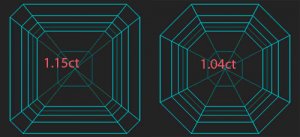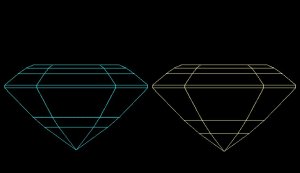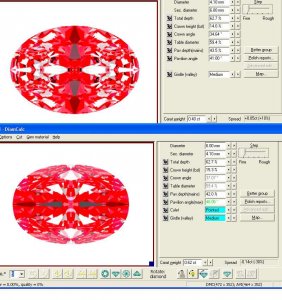- Joined
- Sep 2, 2002
- Messages
- 2,859
This subject is a side-topic that came up in this thread, and probably deserves its own thread.
My point is that one simply cannot say that a deeper fancy shape means that the stone has less spread. This is because of two reasons.
First, in many fancy shapes, there is the length-to-width-ratio. The depth is calculated on the basis of the smallest diameter, the width. So, two stones might have the same depth, but a L/W-ratio that is 15% different. (1.75 is almost 17% more than 1.50). So, the same depth could easily have a difference in spread of 15%.
Second, most fancy shapes do not have just one main crown and pavilion angle. Any stone with multiple crown- and pavilion-angles can hide weight without affecting the spread. I have written articles about this effect in the PS-journal on princess-cuts, but it is even more obvious in step-cuts. Again here, a conservative estimate is that the same depth can hide another 15% in weight in the bulge of the pavilion and the crown.
Taking both into consideration, it shows that two fancy shapes with the same depth-percentage can differ up to 30% in spread.
Considering that the difference between a depth of 60% and one of 78% is also 30%, how can one then use depth to say something about spread?
Live long,
My point is that one simply cannot say that a deeper fancy shape means that the stone has less spread. This is because of two reasons.
First, in many fancy shapes, there is the length-to-width-ratio. The depth is calculated on the basis of the smallest diameter, the width. So, two stones might have the same depth, but a L/W-ratio that is 15% different. (1.75 is almost 17% more than 1.50). So, the same depth could easily have a difference in spread of 15%.
Second, most fancy shapes do not have just one main crown and pavilion angle. Any stone with multiple crown- and pavilion-angles can hide weight without affecting the spread. I have written articles about this effect in the PS-journal on princess-cuts, but it is even more obvious in step-cuts. Again here, a conservative estimate is that the same depth can hide another 15% in weight in the bulge of the pavilion and the crown.
Taking both into consideration, it shows that two fancy shapes with the same depth-percentage can differ up to 30% in spread.
Considering that the difference between a depth of 60% and one of 78% is also 30%, how can one then use depth to say something about spread?
Live long,











300x240.png)